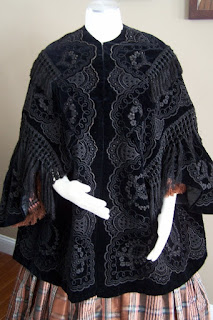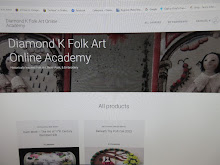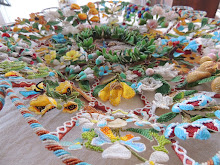1850-5 Embroidered Black velvet Mantilla, 31.1998.15
If you were a fashionable young ladye in the mid 19th century, to keep up with all the latest fashions, there was no greater an anticipated arrival...well, other than ones beau, than the latest edition of Godey's Lady's Magazine. Of coarse there were others....World of Fashion, Sartain's, Petersons, Akermann's Repository ...but Godey's was the most popular and widespread fashion publication here in the US. It came out monthly, and along with stories there were recipes, music, current events, ideas for household amusements, embroidery and craft patterns....and at the very back, before the advertisements, usually 2 hand colored fashion plates and several pages of engravings of the latest styles. They were highly coveted by those that were fortunate to subscribe. Ladies would save them up and take to the book binder to have bound into book volumes. Above is the latest style of mantilla
'The Andalusia" , which bears close resemblance to this weeks Museum Monday lucky number 31!
This piece holds a special place in my heart, as one of the first permanent pieces in my collection. I used to run an ad in the paper when we lived in Maine for any old clothings, and was offered this piece from its original family in Machias, Maine. Its hand stitched of plush black silk velvet, with allover black silk embroidery and fringes, center front hook/eye closure and lined in a quilted silk wadded with wool, making it the perfect covering for a walk in the brisk fall air.
The black is very hard to photograph, but there are separate pagoda sleeves set in very low~ there is absolutely NO picking up ones arms in this! Any bending of the arm or movement was done from the elbow down.
While the back is not cut in quite as deep of a V as the
Raglan , above, it does have the same long fringe treatment....so our mantilla is rather a hybrid of the Andalusia & the Raglan. Let's see what the September 1855 issue of Godey's has to say about the Raglan....
" As the approach of the cold weather will render our Lady friends thoughtful about their winter garments, they will, we trust, be grateful to find that we are at pains to afford them all the information in our power as to the several styles which the modistes of Paris have prepared for the season.
We commence with a beautiful article fashioned of royal purple velvet. It adjusts itself to the figure closely as far as the waist, thus presenting a remarkably elegant contour; three fold box pleats start from this point with fine effect; the balance of the skirt sweeps in a circular manner forward, over and in advance of the arm at the bend of the elbow, thus forming a covering for it. The front falls in tabs cut nearly square, but rather drooping towards the forward edge. The manner in which the trimming ornaments the upper portion will be understood at a glance; it is arranged similarly in front. We need scarcely observe that it is composed of a rich guipure lace with massive fringe. The lining is of satin, beautifully quilted in an elaborate design."

Our mantilla does not have any lace, and here, you can see the embroidered sleeve~ its set into the body of the coat right at the fringe there. The shine of the black silk embroidery, along with the pattern itself, has the look of lace against the deep pile of the black velvet.
From afar, the embroidery really looks like a lace flounce
Padded satin stitch, chain stitch, french knotts were worked to make this beautiful design, similar to many published each month in Godey's...which I think, is just as entertaining to read today, as it was 161 years ago!








































































